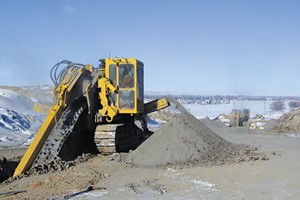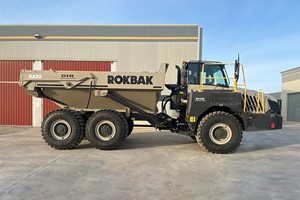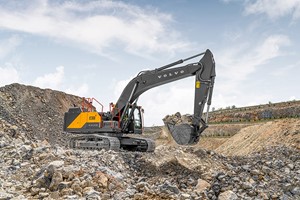In the 1970s, new residential developments were being built with all utilities underground. Of course, water, sewer, and gas lines always had been buried, but now telephone and electric dissertation wires were, too, as would cable television services that would come later.
All utilities underground became a selling point: no unsightly utility poles and overhead wires; no downed and dangerous utility lines from severe storms.
Most of the underground construction was done with compact utility trenches, small walk-behind marine and larger riding trenchers. Bigger trenchers made longer runs.
Vibratory plows began to play an increasingly important role. When conditions were suitable, the narrow slit left in the ground by the plow blade was easier to restore after the installation. But a plow blade could strike and damage any existing utility in its path.
Today, most project articles in industry trade magazines tend to cover trenchless methods, horizontal directional drilling (HDD), pipe bursting and various rehabilitation methods. Have the various trenchless technologies made trenching equipment obsolete?
The answer is a loud “No.”
Trenchers that dig a relatively narrow trench to the depth necessary for each type of utility, remain the fastest, least costly method of putting utilities in the ground. An important added benefit trenching offers is when circumstances are right, multiple utilities can be placed in the same trench, reducing costs for all participating companies.
Two companies – Ditch Witch and Vermeer – dominate this market and representatives of both companies say that trenchers are essential for installing underground utilities.
Steve Seabolt, category manager for Ditch Witch trenchers, and Ed Savage, Vermeer product manager, discussed with Underground Infrastructure the importance of trenchers for utility construction today.
Have trenchless technologies made trenching obsolete for utility construction?
Seabolt: Trenching and other types of open-cut methods are popular solutions for installation of cable or pipe products over long distances, in areas with minimal surface obstructions. They are also selected often for extremely short or shallow jobs, such as a “drop” from street to home, or for installation of a lawn sprinkler system.
Trenchers are the go-to solution if the design of the job requires the product be Tee’d, branched, joined, or physically manipulated in some other way during installation. Trenchers (and sometimes plows) are often chosen when there are requirements for sand to be placed above or below the product.
Plows, in particular, are capable of installing small-diameter pipes or cables at a very fast pace, compared to most other methods, and are often the installation tool of choice when productivity is critical. Saws, or disc trenchers, are often selected when installing product in solid rock or frozen ground, especially for short or shallow distances. Microtrenchers are chosen to cut asphalt roadways when the roadside easement is crowded or covered with surface obstructions that might inhibit setup of an HDD rig.
Savage: Horizontal directional drilling does get a lot of attention for installing underground utilities, but dedicated trenchers still play a significant role in the installation process. Trenchers and vibratory plows are widely used to install utilities over long distances in more rural areas, where there are fewer restoration requirements.
Small walk-behind trenchers and vibratory trenchers are often used to install electrical, telecom, water and gas lines to homes and businesses. Mid-size rubber tire/track trenchers and vibratory plows are employed on longer installation projects. Large trenchers are an excellent option for utility jobs in challenging rocky grounds.
Also, trenching tends to be the preferred method for installing new utilities on greenfield development projects, where existing underground infrastructure might be limited.
What factors influence whether trenching or HDD will be used?
Seabolt: Ground conditions, depth, distance, product being installed, padding (beneath the pipe) or special cover requirements like sand, surface obstructions, desired speed, skilled labor availability are among the considerations.
Savage: The main factor contractors should use to determine whether to trench or use a horizontal directional drill is location.
In urban areas, there are typically more above-ground obstacles like roads, driveways and buildings that contractors have to account for. So, using trenchless installation methods like horizontal directional drilling, auger boring and piercing tools tends to be more efficient than cutting through hard surfaces and then repairing them.
Rural areas have fewer road intersections and other obstacles. Trenching or using a vibratory plow in these areas is typically faster than using HDD alone. Drills are still often used to make road and river crossings.
Other factors that contractors should think about are the utility bundle size, installation depth and ground conditions. These will influence the size of the trencher, vibratory plow or HDD used on a job.
For example, if a contractor is installing small-diameter electrical or fiber lines at a shallow depth in soft soil conditions, a vibratory plow is likely the best option. However, if installing larger distribution lines and depths of more than a few feet, contractors will likely need to choose a mid-size trencher.
In rock and when installing large-diameter products at depths greater than 5 feet, they may consider using a higher horsepower trencher with a larger boom and chain configuration that allows them to cut a trench the required width.
One more consideration that can influence the decision between HDD and trenching is equipment availability. Unlike directional drills, trenchers are typically available at rental stores. Renting can be an attractive solution if the contractor only has a minimal amount of product to install.
Jeff Griffin












